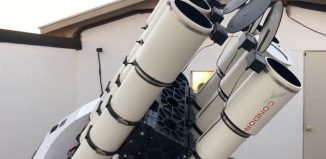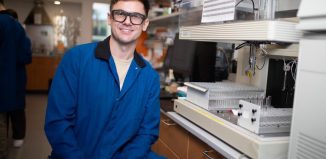SBU’s Perena Gouma and team work to beat asthma
Developing an inexpensive device to measure inflammation in the lungs
It’s an all-too-familiar fear. A parent hears a child struggling to breath in the next room, jumps out of bed and wonders whether to grab the child and race to the hospital or call 911.
Researchers from Stony Brook are working to let children (and their parents) breathe a little easier, at least in terms of knowing the severity of an asthma or breathing attack.
Led by Perena Gouma, a professor in the Department of Materials Science and Engineering, along with Milutin Stanacevic, an associate professor in the Department of Electrical and Computer Engineering, and Sanford Simon, a professor in biochemistry and cell biology and pathology, the scientists are developing a nanosensor-based system (i.e., extremely small) that captures, quantifies and displays an accurate measure of the nitric oxide concentration in one exhaled breath.
Nitric oxide is a known marker for measuring airway inflammation.
The scientific trio received a three-year award for $599,763 from the National Science Foundation to develop the monitor.
Creating an affordable, personalized device like this — Gouma estimates the finished product could cost between $20 and $50 — is “urgent” for people who struggle with asthma, she explained. “It’s a matter of working hard and getting this out as soon as possible.”
The group that might use something like this includes young children, the elderly and incapacitated patients.
Hospitals currently employ devices that monitor nitric oxide, but they use gas chromatography, which cost upwards of $10,000 and require considerably more air. They also use chemiluminescence detectors, which cost $30,000.
Through nanotechnology, Gouma and her team hope to screen for nitric oxide in a single breath and at a cost that’s affordable in a home.
“We can measure hundreds of molecules of nitric oxide in billions of molecules of air,” Gouma explained. “We would like to take that sensitivity down one or two orders of magnitude, so that we can measure a few molecules in billions of molecules of air.”
Gouma said the monitor not only could diagnose the severity of an asthma attack, but might also help prevent one.
Users can “exhale once a day and record the concentration of nitric oxide,” she offered.
“If you see that nitric oxide is elevated” you might prevent an imminent attack.
Different concentrations of the signal gas might also lead to different treatments, she suggested. By developing such a diagnostic tool, Gouma and her colleagues believe some patients may be able to take medication only when their body signals they need it.
The concept for the nitric oxide detector is similar to what police use when they administer breathalyzer tests to people as an noninvasive way of determining how much alcohol they’ve consumed. The technology, however, is different.
The breathalyzer uses resistive sensors that are nonselective and respond to all hydrocarbons, while the nanotechnology, which uses crystal nanowires, has a selectivity for one particular gas.
Gouma, who leads the project with her material science background, has teamed up with Stanacevic and Simon on other projects and believes the combination of their skill sets will make a prototype possible in the next year or so.
Stanacevic will work on the microelectronics, while Simon will carry out the trials in the early stages, once the trio has produced a new monitor.
“This is an interdisciplinary approach,” explained Gouma.
A resident of Port Jefferson, Gouma, who is originally from Greece, has been on Long Island for 12 years. She is married to Antonios Michailidis. They have a son in kindergarten.
A world traveler who has spent time in England, Italy, Switzerland, Japan, Australia and Brazil, Gouma calls Long Island the “best place to be.” On the board of the Maritime Museum in Port Jefferson, she praised the region’s smaller museums, including the Whaling Museum in Cold Spring Harbor.
“We really enjoy the lifestyle on Long Island,” she said. “It is so serene, peaceful and safe. At the same time, you get the feeling you are in a metropolitan area.”
She believes Long Island could become the equivalent of Silicon Valley for the rapidly expanding world of bionanotechnology.
“If we were to set up a lot of activity in developing, manufacturing, testing and selling” various nanomedical devices, Long Island could easily become a business hub that would attract investment and industry, she urged.






